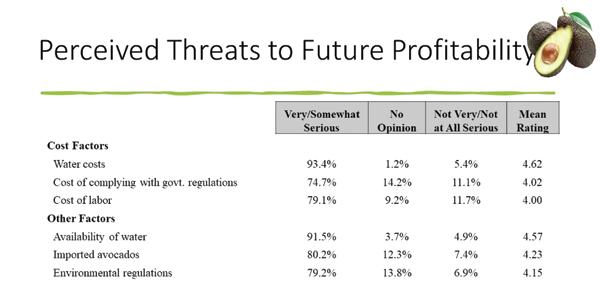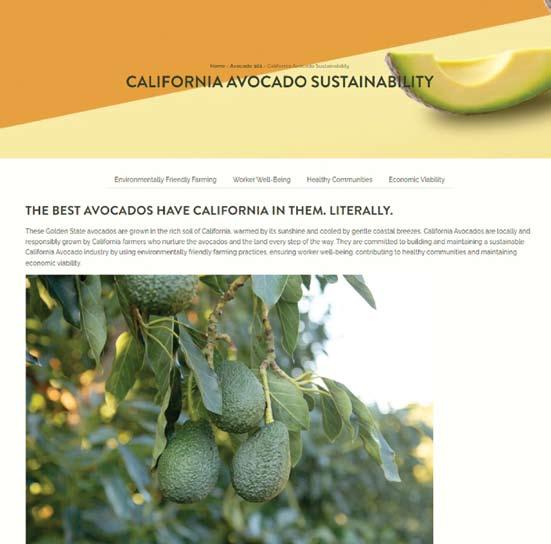
8 minute read
CHAIRMAN’S LETTER
Fiscal year 2020-21 was a year of adjusted expectations. A June heat wave, a far-reaching drought and strong winds resulted in a 257 million pound crop that was smaller — both in volume and size structure — than originally projected. And the pandemic, which we hoped would recede, continued to strain our operations. But throughout, I have remained bullish about our future. Not simply because as a grower I have weathered plenty of difficult seasons, but because my years with the California Avocado Commission have demonstrated that our staff, marketing team, board and growers make every effort to ensure our industry thrives, no matter the challenges. At the micro level consider this year’s smallersized, lower volume crop. By increasing the frequency of crop survey data and refining the tools we use to gather that information, we have enabled our marketing team to be better positioned to customize and time promotions to complement fruit size and harvest volume. At the macro level, we have dedicated years of hard work to establishing our premium brand, improving the use of data for everything from research to marketing, and developing partnerships to strengthen our advocacy efforts. With a safety net as robust as this, our industry is — and will continue to be — capable of making nimble adjustments to revised expectations.
I’m also bullish about our future because this year the statewide grower referendum, which represented the first vote since the Commission exempted smaller growers, approved the continued operation of the Commission for the next five years. The referendum, which passed with overwhelming support (75%), will ensure we can continue efforts to refine our industry and constructively solve problems. Just as we adapted our crop survey tools to provide us with more accurate data to fuel our marketing decisions, we will continue to search for the next big challenge on the horizon so we can adapt our production research and industry affairs programs and proactively address issues before they spiral out of control. Further, we will continue to develop robust programs to help growers improve on-farm practices that drive higher productivity and profitability.
Advertisement
With GEM avocado acreage increasing in California groves and the fruit a popular discussion point with retailers, the Commission added the fruit to its popular avocado variety browser and GEM assets to its online pressroom.
Rob Grether
Chairman
This year, the Commission conducted a study to collect concrete data on the profitability of the California avocado industry and the operating characteristics of our diverse avocado enterprises. We are grateful to the growers who participated in the State-of-the-Industry survey and provided us with 2018-20 production, crop value, gross income, total expenses, water source and irrigation cost data, as well as their feedback concerning the most serious threats to their profitability. Ultimately, their active participation provided the Commission with a more representative spectrum of profitability and a more accurate picture of profit and loss within our industry. Data indicated that while yields are declining slightly, crop values are holding steady. Respondents also reported continued growth in revenues, but it is clear expenses are growing at a faster rate and applying pressure on growers’ net margins. Findings from the survey indicated irrigation costs remain significant, but are not the single major cause of increasing total expenses — rather, growers indicated costs associated with labor and compliance play a significant role in profitability. Although the survey data indicates many of our growers remain profitable, the pace at which operational costs are rising is a clear call-to-action and the Commission will use the findings from this report to assess growers’ most pressing challenges and develop strategies to help growers optimize their yields.
For the past several years, the Commission has made concerted efforts to address increasing consumer and trade interest in sustainability by identifying the California avocado industry’s sustainability practices and the hundreds of laws our growers must comply with. This year, the Commission launched a sustainability webpage on the CaliforniaAvocado.com consumer website showcasing our environmentally friendly farming methods, our commitment to worker well-being, and the role California groves play in supporting healthy communities and economic viability. To build awareness of our sustainability practices, the Commission invited Assemblyman Robert Rivas, chair of the Assembly Agriculture Committee, to visit Jason Mraz’s California avocado grove and witness first-hand our sustainable growing practices and discuss how our groves
help protect the environment during wildfires, contribute to local economies and improve surrounding communities by reducing urban sprawl. We also shared the challenges our growers face and advocated for recognizing and incentivizing growData from the Commission’s grower profitability study indicated that while irrigation costs remain significant, other major cost factors play a critical role in the profitability of an operation. ers’ existing contributions to a healthy climate. As a result, the Commission was invited to work with Rivas on an avocado pilot program to preserve and expand the ecosystem benefits of avocado grove practices, and Jason Mraz was provided the opportunity to testify at an Assembly informational meeting on Environmental Farming as our industry ambassador. With an eye to protecting our industry, the Commission remains diligent about identifying potential pest infestations caused by global avocado imports. To that end, the Commission submitted extensive comments to the Animal and Plant Health Inspection Service concerning the major threat the avocado seed moth, associated with Ecuadorian avocado imports, posed to quarantine security. In addition, CAC staff met with APHIS staff in Washington, D.C. to call for mandatory surveys of Ecuadorian production areas. As a result, APHIS revised the 2018 proposed rule to include the Commission’s recommended surveillance protocols, ensuring sites with detected pests are prohibited from exporting avocados to the U.S. until the risk has been mitigated. On the labor front, the Commission continued to advocate for access to a secure and reliable workforce by signing a letter of support for passage of the

Farm Workforce Modernization Act and maintained its active role as a member of the Agriculture Coalition for Immigration Reform.
To support interest from California growers, the Commission expanded research and outreach efforts on the GEM variety. Favorable tree and fruit characteristics of the GEM variety — a compact tree structure well-suited to high-density planting, robust foliage that protects from sunburn and early-season, high yields of large fruit — have led it to become a popular choice with growers in recent years and is gaining attention from retailers. Given this increasing interest in GEM, the Commission established a multiyear (4-5 years) research trial to evaluate the feasibility of increasing GEM avocado grove productivity through high density planting. The Commission also reported findings from a GEM scarring trial, which indicated that windbreaks and windscreens could be useful in minimizing fruit scarring. In response to grower questions about the variety, the Commission also shared GEM observations and recommendations from a local nursery. To address consumer interest in the variety, CAC added information on GEMs to the consumer website and online pressroom to improve search engine results and establish CAC as a go-to source for GEM information.
On the pest management front, the Commission adopted a proactive management approach to the large avocado seed weevil by launching a three-year project designed to develop management tools in advance of the pest becoming a threat. The new study seeks to identify pheromones that attract the pest to feeding and mating sites, determine the weevil’s natural enemies and examine biological characteristics — such as flight patterns and avocado preferences — that could provide researchers with effective mitigation strategies.
The Commission also devoted significant efforts to continued research concerning avocado branch canker, which has become increasingly common. This year the Commission shared findings identifying Botryosphaeria as the primary causal agent of Avocado Branch Canker, confirmed wounds are the primary infection sites for the disease and outlined the best ABC disease management strategies when pruning. In the coming years, CAC will investigate optimal fungicides that
The Commission invited Assembly Ag Committee Chair Robert Rivas to tour Jason Mraz’s California avocado grove to learn more about how groves protect the environment and make positive impacts on local economies and communities. Jason also testified before the Assembly Informational Hearing on Environmental Farming on behalf of the California avocado industry.

The new California Avocado Sustainability webpage shares California avocado growers’ commitment to environmentallyfriendly farming, worker well-being, healthy communities and economic viability. protect from ABC during pruning.
Findings from the Commission’s State-of-the-Industry Survey indicated the biggest factor to mitigating increasing production costs is increasing California avocado yields. The Commission remains committed not only to conducting research to address potential and current challenges faced by California avocado growers, but also ensuring growers have access to information that can help them improve their yields. To that end, throughout the year CAC shared critical cultural management information via the bi-weekly GreenSheet and on the California avocado grower website including articles to help growers interpret soil/leaf/water analyses, best harvesting practices, and methods of coping with the extremes of climate change. In addition, the Commission hosted both in-person field days and virtual seminars to address some of the most pressing topics. Growers were invited to learn about the insights gleaned from the Commission’s Pine Tree Ranch fertility program, as well as the California avocado rootstocks and GEM avocado trials being conducted at Pine Tree Ranch. CAC collaborated with experts from New Zealand and UC-Riverside to produce an avocado nitrogen and fertility webinar, and hosted its own heat mitigation strategies session for growers. To help growers cope with the continued pressures placed on their operations by COVID, the Commission consistently shared information about COVID protocols and funding resources for operations impacted by the pandemic. Further, CAC gathered and shared information regarding organic certification, mandated FSMA produce training sessions, disaster assistance, and drought, water conservation and irrigation system evaluation resources.
As we move forward, I am encouraged by the opportunities ahead. As diverse as our California avocado operations are, every one of our growers is committed to growing premium fruit that represents the best this state has to offer. And we are backed by a strong support network of expert Commission staff, dedicated board members, and committed industry partners and advocates who will help us continually pursue opportunities to improve our industry and support our vision to grow and market the most-desired avocados in the world.



